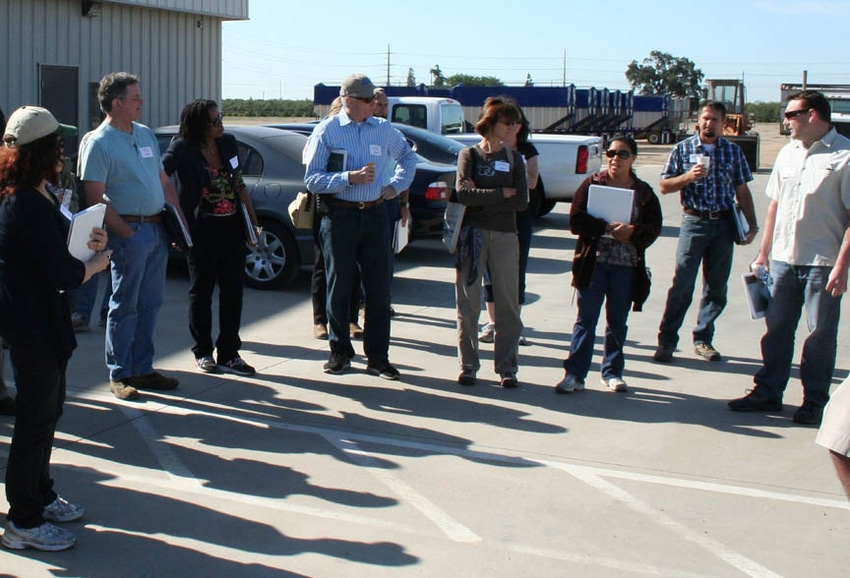July 8, 2013

State and federal regulators who craft rules that impact agriculture related to water and air quality, endangered species, pesticide and fertilizer use attended the Almond Board’s ninth annual Environmental Stewardship Tour on May 17, joining elected officials, media and other invited tour guests at Salida Hulling Association in Modesto.
The Environmental Stewardship Tour provides a forum for almond growers to share the innovative ways they are addressing environmental challenges, while giving regulators a first-hand glimpse at current almond farming practices. For many of the guests, it is their first time inside an almond orchard.
Almond grower Gordon Heinrich, whose family-farming legacy in Stanislaus County spans five generations, cohosted this year’s tour with third-generation Modesto-area grower Garrett Bowman. Heinrich grows almonds, walnuts and field crops on some 650 acres, while Bowman works 550 acres of almonds. Both are long-time members of the 120-member Salida Hulling cooperative.
Changes in Nitrogen Management
Bowman said nitrogen applications have evolved over the years for almond growers, who not long ago relied on one or two higher rates of application of macronutrients during the season, but today spoon-feed those nutrients throughout the growing season as needed. Rates are based on leaf sampling conducted at the end of the previous growing season and nitrogen budgeting protocol. Sebastian Saa, from UC Davis, discussed research on new methods for adjusting those rates according to results of in-season tissue sampling. Some of that research took place in one of Bowman’s orchard, highlighting the partnership between growers and researchers.
“In the past our N management plan was to take leaf samples in July to see where our N management ended up, and then we would make adjustments for the following year,” Bowman said. “We would start off with a fairly large nitrogen application in the fall, followed by an application at bloom time and then one again in early summer.
“We’ve evolve from that to where we are making a small application in fall followed by a small application around bloom time. Then we take tissue analysis in April, use university models to predict what our July levels will be and then we make in-season adjustments that same year based on estimated crop load,” Bowman said.
Sustainable Pest Management
Bowman told the tour participants that his pest management plan also revolves around sampling and monitoring and using the most sustainable control method possible.
“When we do determine there is a pest problem, we look at any mechanical means that may be available to control that pest and all options available to make a decision based on the effects on the environment, cost and ease of application,” he said.
Despite having a relatively abundant supply of high-quality surface water through Modesto Irrigation District, Heinrich said he integrates technology and tree water status measurements to deliver the right amount of water to the root zone. This not only improves yield and quality, but also reduces the chance that water is moving off-site or saturating the root zone.
Tools for Water Management
Heinrich’s son Eric demonstrated use of the pressure chamber and real-time soil moisture monitoring to dial in timing and rate of water applications for optimum efficiency. Using a pressure chamber also helps him induce moderate stress to use deficit irrigation for hull rot management.
“Water management is the key to successfully growing an almond crop,” Heinrich said. “If you do water management right, everything else falls in behind it.”
Both Heinrich and Bowman participate in the California Almond Sustainability Program (CASP), attending workshops and completing online assessments of their almond growing practices related to irrigation and nutrient management, energy efficiency, air quality and pest management.
For these growers, the primary motive in participating in CASP and implementing environmentally sensitive practices is to improve efficiency. But, like other growers, Bowman says the added benefit is to prove to regulators, almond retailers and others that they are addressing environmental concerns voluntarily. This is particularly important as regulators, for example through the Irrigated Lands Regulatory Program, consider ways that improved water and nutrient management can reduce potential impacts to surface and groundwater.
“I think it’s important for growers to participate in CASP to tell the world we are growing almonds in a safe and sustainable way,” Bowman said.
Regulators in attendance noted that the Environmental Stewardship Tour provides an opportunity to see almond-growing practices first-hand and to further communicate with growers who are affected by the decisions they make.
Boots on the Ground
Brian Leahy, director of the California Department of Pesticide Regulation, attended his second environmental stewardship tour on May 17, saying it is helpful for him and his staff to visit an almond operation in person.
“It’s great for staff who are trying to figure out regulations to be on the ground; to see the almonds but also to see the growers and realize these are human beings trying to do a very complex task and to see their challenges,” he said.
More from Western Farm Press
Oregon GMO mystery wheat is a whodunit
What a grocery store without honey bees looks like
EPA’s Pinocchio nose grows with farmer privacy scandal
5 lessons from the Honeygate scandal
You May Also Like




